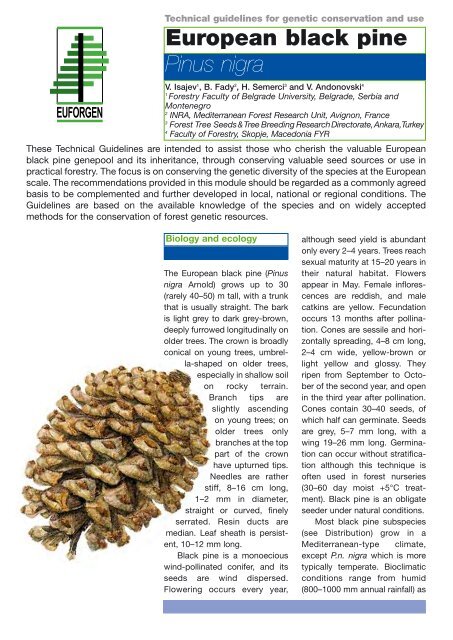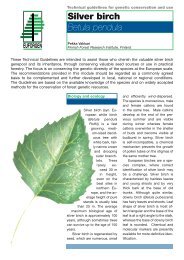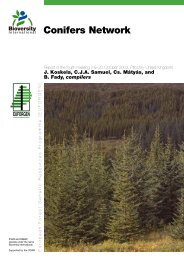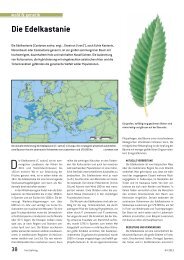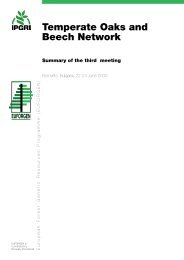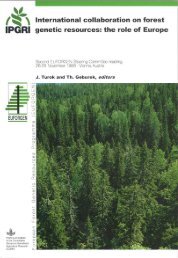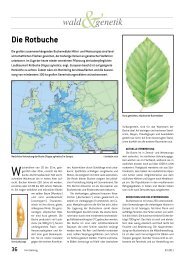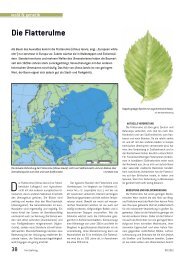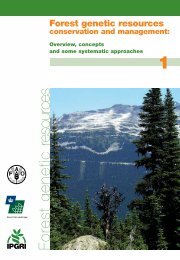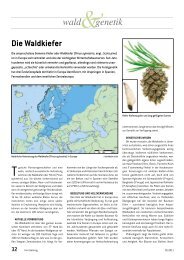Pinus nigra - Euforgen
Pinus nigra - Euforgen
Pinus nigra - Euforgen
Create successful ePaper yourself
Turn your PDF publications into a flip-book with our unique Google optimized e-Paper software.
EUFORGEN<br />
Technical guidelines for genetic conservation and use<br />
European black pine<br />
<strong>Pinus</strong> <strong>nigra</strong><br />
V. Isajev 1 , B. Fady 2 , H. Semerci 3 and V. Andonovski 4<br />
1<br />
Forestry Faculty of Belgrade University, Belgrade, Serbia and<br />
Montenegro<br />
2<br />
INRA, Mediterranean Forest Research Unit, Avignon, France<br />
3<br />
Forest Tree Seeds&Tree Breeding Research Directorate, Ankara,Turkey<br />
4<br />
Faculty of Forestry, Skopje, Macedonia FYR<br />
These Technical Guidelines are intended to assist those who cherish the valuable European<br />
black pine genepool and its inheritance, through conserving valuable seed sources or use in<br />
practical forestry. The focus is on conserving the genetic diversity of the species at the European<br />
scale. The recommendations provided in this module should be regarded as a commonly agreed<br />
basis to be complemented and further developed in local, national or regional conditions. The<br />
Guidelines are based on the available knowledge of the species and on widely accepted<br />
methods for the conservation of forest genetic resources.<br />
Biology and ecology<br />
The European black pine (<strong>Pinus</strong><br />
<strong>nigra</strong> Arnold) grows up to 30<br />
(rarely 40–50) m tall, with a trunk<br />
that is usually straight. The bark<br />
is light grey to dark grey-brown,<br />
deeply furrowed longitudinally on<br />
older trees. The crown is broadly<br />
conical on young trees, umbrella-shaped<br />
on older trees,<br />
especially in shallow soil<br />
on rocky terrain.<br />
Branch tips are<br />
slightly ascending<br />
on young trees; on<br />
older trees only<br />
branches at the top<br />
part of the crown<br />
have upturned tips.<br />
Needles are rather<br />
stiff, 8–16 cm long,<br />
1–2 mm in diameter,<br />
straight or curved, finely<br />
serrated. Resin ducts are<br />
median. Leaf sheath is persistent,<br />
10–12 mm long.<br />
Black pine is a monoecious<br />
wind-pollinated conifer, and its<br />
seeds are wind dispersed.<br />
Flowering occurs every year,<br />
although seed yield is abundant<br />
only every 2–4 years. Trees reach<br />
sexual maturity at 15–20 years in<br />
their natural habitat. Flowers<br />
appear in May. Female inflorescences<br />
are reddish, and male<br />
catkins are yellow. Fecundation<br />
occurs 13 months after pollination.<br />
Cones are sessile and horizontally<br />
spreading, 4–8 cm long,<br />
2–4 cm wide, yellow-brown or<br />
light yellow and glossy. They<br />
ripen from September to October<br />
of the second year, and open<br />
in the third year after pollination.<br />
Cones contain 30–40 seeds, of<br />
which half can germinate. Seeds<br />
are grey, 5–7 mm long, with a<br />
wing 19–26 mm long. Germination<br />
can occur without stratification<br />
although this technique is<br />
often used in forest nurseries<br />
(30–60 day moist +5°C treatment).<br />
Black pine is an obligate<br />
seeder under natural conditions.<br />
Most black pine subspecies<br />
(see Distribution) grow in a<br />
Mediterranean-type climate,<br />
except P.n. <strong>nigra</strong> which is more<br />
typically temperate. Bioclimatic<br />
conditions range from humid<br />
(800–1000 mm annual rainfall) as
inus <strong>Pinus</strong><br />
ropean black pine<strong>Pinus</strong> <strong>nigra</strong>European black pine<strong>Pinus</strong> <strong>nigra</strong>European black pineP<br />
in P.n. mauretanica or P.n. laricio,<br />
to subhumid (600–800 mm) as in<br />
P.n. pallasiana in Cyprus, to<br />
semi-arid (400–600 mm) as<br />
in P.n. pallasiana in Anatolia.<br />
The optimal altitudinal<br />
range of black pine is<br />
between 800 to 1500 m.<br />
However, a considerable altitudinal<br />
variation can be<br />
observed: from 350 to 1000 m<br />
in Italy (P.n. <strong>nigra</strong>) and on the<br />
Croatian coast (P.n. dalmatica),<br />
from 500 to 900 m in the French<br />
Pyrenees and 1600 to 2000 m in<br />
Spain (P.n. salzmannii), from<br />
1000 to 1600 m in Corsica (P.n.<br />
laricio), from 1000 to 2200 m in<br />
the Taurus mountains and 1400<br />
to 1800 m in Cyprus (P.n. pallasiana)<br />
and from 1600 to 1800 m<br />
in North Africa (P.n. mauretanica).<br />
Black pine can grow on a<br />
variety of substrates: limestone<br />
(e.g. P.n. mauretanica, P.n. dalmatica,<br />
P.n. pallasiana in Central<br />
Greece), dolomites (e.g. P.n.<br />
<strong>nigra</strong> in northern Italy and Austria,<br />
P.n. salzmanni in the<br />
Cévennes, France), acidic soils<br />
(P. n. laricio, P.n. pallasiana in<br />
Anatolia, P. n. salzmanni in the<br />
French Pyrenees) or volcanic<br />
soils (P.n. laricio in Sicily).<br />
Black pine is a light-demanding<br />
species, intolerant of shade<br />
but resistant to wind and<br />
drought. It grows in pure stands<br />
or more rarely in association with<br />
other pines such as P. sylvestris<br />
or P. uncinata.<br />
Distribution<br />
Black pine extends over more<br />
than 3.5 million hectares from<br />
western North Africa through<br />
southern Europe to Asia<br />
Minor. Owing to this large<br />
albeit discontinuous range<br />
and its large genetic and<br />
phenotypic variability, it<br />
is regarded as a collective<br />
species. Although<br />
there is no definite consensus<br />
on its taxonomy,<br />
six main subspecies can<br />
be recognized from North Africa<br />
to the Crimea.<br />
<strong>Pinus</strong> <strong>nigra</strong> mauretanica<br />
(Maire et Peyerimh.) Heywood<br />
covers only a few hectares in the<br />
Rif mountains of Morocco and the<br />
Djurdjura mountains of Algeria.<br />
<strong>Pinus</strong> <strong>nigra</strong> salzmannii (Dunal)<br />
Franco (syn: P. n. clusiana, P. n.<br />
pyrenaica) covers extensive<br />
areas in Spain (over 350 000 ha<br />
from Andalucia to Catalunia and<br />
on the southern slopes of the<br />
Pyrenees) and is found in a few<br />
isolated populations in the Pyrenees<br />
and Cévennes in France.<br />
It is sometimes referred to as the<br />
Pyrenean pine.<br />
<strong>Pinus</strong> <strong>nigra</strong> laricio (Poiret) is<br />
found in Corsica (Corsican pine)<br />
over 22 000 ha, in Calabria<br />
(where it is also recognized as P.<br />
n. l. calabrica, the Calabrian pine)<br />
and in Sicily.<br />
<strong>Pinus</strong> <strong>nigra</strong> <strong>nigra</strong> (syn: P.n.<br />
austriaca Höss, P.n. nigricans<br />
Host, the Austrian pine) is found<br />
from Italy in the Apennines to<br />
northern Greece through the<br />
Julian Alps and the Balkan<br />
mountains, covering more than<br />
800 000 ha.<br />
<strong>Pinus</strong> <strong>nigra</strong> dalmatica (Vis.)<br />
Franco, the Dalmatian pine, is<br />
found on a few islands off the<br />
coast of Croatia and on the<br />
southern slopes of the Dinaric<br />
Alps.<br />
<strong>Pinus</strong> <strong>nigra</strong> pallasiana (Lamb.)<br />
Holmboe covers extensive areas,<br />
mostly in Greece and Turkey (2.5<br />
million ha, 8% of total forest<br />
area) and possibly as far west as<br />
Bulgaria. It can also be found in<br />
Cyprus and the Crimea. It is<br />
sometimes referred to as the<br />
Crimean pine.
inus <strong>nigra</strong>European black pine<strong>Pinus</strong> <strong>nigra</strong>European black pine<strong>Pinus</strong> <strong>nigra</strong>European b<br />
Importance and use<br />
Black pine is one of the most<br />
economically important native<br />
conifers in southern Europe. Early<br />
growth is rather fast. It is widely<br />
planted outside its natural<br />
range. Wood is durable and rich<br />
in resin, easy to process.<br />
P.n. laricio is appreciated<br />
for building and<br />
roofing because of its<br />
straightness and thin branches.<br />
If properly thinned, its low<br />
amount of duramen makes it a<br />
fine carpentry and cabinetry<br />
wood. The same use can be<br />
made of Calabrian pine, although<br />
it is more branchy. Wood of P.n.<br />
<strong>nigra</strong> is of lower quality and thus<br />
restricted to lower-grade building<br />
wood and the making of crates.<br />
Black pine has a mean productivity<br />
of 8–20 m 3 ha -1 yr -1 when<br />
grown as a monoculture on<br />
fertile soils. In natural<br />
conditions, productivity<br />
is 6–10 m 3 ha -1 yr -1 and<br />
down to less then 3 m 3 ha -1<br />
yr -1 on the driest sites.<br />
Because of its ability to<br />
develop well on open lands<br />
and in ecologically demanding<br />
situations, Austrian pine was<br />
intensively used during 19 th and<br />
early 20 th century reforestation<br />
programmes, e.g. in the French<br />
southern Alps for landslide control<br />
and land rehabilitation and in<br />
England and the USA for sanddune<br />
fixation and as a windbreak.<br />
Currently P.n. laricio is the<br />
most important reforestation<br />
species in southern England as<br />
well as in some French regions<br />
(e.g. Loire valley).<br />
Black pine is also valued for<br />
landscaping, both in parks (isolated<br />
trees or in groups) and in<br />
urban and industrial contexts<br />
because of its tolerance to pollution.<br />
It is one of the most<br />
common introduced ornamentals<br />
in the USA. Other uses<br />
include Christmas trees, fuel<br />
wood and poles.<br />
Black pine is included in<br />
the European Council Directive<br />
1999/105/CE (December<br />
22 1999) on the marketing<br />
of forest reproductive<br />
material. Minimum<br />
requirements have to<br />
be met before black<br />
pine seed can be<br />
sold for reforestation.<br />
Genetic knowledge<br />
The first black-pine-type fossils<br />
date to the Miocene, about 20<br />
million years ago. The ice cycles<br />
that shaped the Quaternary period<br />
in Europe are believed to have<br />
been responsible for the currently<br />
very discontinuous range of black<br />
pine. This geographic separation<br />
did not result in mating barriers,<br />
and all subspecies are interfertile<br />
under experimental conditions.<br />
Studies using morphological and<br />
genetic markers have confirmed<br />
the common phylogenetic origin<br />
of all black pines. The most divergent<br />
and genetically original European<br />
groups are P.n. salzmanii<br />
and P. n. laricio, although P.n.<br />
<strong>nigra</strong>, dalmatica and pallasiana<br />
appear quite similar. The amount<br />
of genetic diversity is also high<br />
within populations. Experiments<br />
measuring adaptive traits have<br />
revealed strong within- and<br />
among-population variability for<br />
traits such as vigour, form and<br />
drought, frost and disease resistance.<br />
It is this huge adaptive plasticity<br />
that has made black pine<br />
such a favourite for reforestation<br />
projects over a wide range of<br />
environments.<br />
In the middle of the 20 th century,<br />
several provenance trials<br />
were established independently<br />
in Europe, the USA and New<br />
Zealand. The Corsican and Calabrian<br />
black pine provenances<br />
were found to be the best in<br />
almost every respect on siliceous<br />
soils. They had consistently
ack pine<strong>Pinus</strong> <strong>nigra</strong>European black pine<strong>Pinus</strong> <strong>nigra</strong>European black pine<strong>Pinus</strong> <strong>nigra</strong>Eu<br />
excellent stem form and branching<br />
habit, gave the greatest volume<br />
production and were hardy<br />
against winter and late frosts<br />
(except in north-central USA).<br />
The major defect reported is<br />
branch forking, which is both<br />
heritable and highly correlated<br />
with polycyclism and branch<br />
angle. On calcareous soils, P.n.<br />
laricio does not perform well and<br />
is to be replaced by the slowergrowing<br />
but more Ca-tolerant<br />
P.n. <strong>nigra</strong>. In dry climates (as in<br />
inner Anatolia, Turkey), black<br />
pine is slow growing and breeding<br />
programmes for such zones<br />
are focused on improving growth<br />
rate and increasing drought and<br />
frost tolerance through withinpopulation<br />
selection.<br />
Intraspecific hybridization is<br />
easily performed among all black<br />
pine subspecies (a further proof<br />
of phylogenetic relatedness), but<br />
has not contributed any outstanding<br />
genotypes to breeding<br />
programmes so far. Interspecific<br />
crosses seem to be possible at a<br />
low survival rate with P.<br />
sylvestris.<br />
Black pine seed orchards<br />
have been established in several<br />
European countries, e.g. in France<br />
there are one Calabrian pine and<br />
two Corsican pine seed orchards.<br />
Current experiments in vegetative<br />
propagation include micropropagation<br />
of zygotic embryos and<br />
brachyblasts as well as somatic<br />
embryogenesis. Propagation by<br />
grafting has been known since<br />
1820; the method generally used<br />
is lateral grafting.<br />
Threats to<br />
genetic diversity<br />
Black pine is not recognized as a<br />
threatened species although<br />
some of its sub-Mediterranean<br />
endemic populations constitute<br />
priority habitats under the EU<br />
Natura 2000 directive (Habitat<br />
Directive n° 92/43/CEE, May 21<br />
1992).<br />
Extensive plantations were<br />
often made across Europe in the<br />
past two centuries with material<br />
from unknown and/or very distant<br />
sources for which no historical<br />
traces currently exist. This<br />
has probably resulted in extensive<br />
mixing of local and imported<br />
genepools all over the distribution<br />
area of black pine.<br />
Damaging insects include<br />
European black pine shoot moth<br />
(Rhyacionia buoliana), pine processionary<br />
caterpillar (Thaumetopoea<br />
pityocampa), especially<br />
in warm and dry climates, and tip<br />
blight (Sphaeropsis sapinea),<br />
which has been particularly<br />
active in France and Turkey in<br />
1990’s. Other pests such as<br />
Acantholyda hieroglyphica, Diprion<br />
pini, Pissodes validirostis and<br />
Monophlebus hellenicus have<br />
been active in Turkey. Most<br />
recently, an increase in the<br />
impact of a needle blight known<br />
as the ‘red band disease’ (Dothistroma<br />
septospora) has been<br />
reported.
Pinu<br />
European black pine<strong>Pinus</strong> <strong>nigra</strong>European black pine<strong>Pinus</strong> <strong>nigra</strong>European black<br />
Distribution range of European<br />
black pine<br />
In areas where black pine is<br />
widespread and very important<br />
for forestry, factors such as forest<br />
fires and illegal cutting cause<br />
serious damage. In areas where it<br />
occurs in small isolated populations,<br />
major risks come from any<br />
factor that may provoke local<br />
extinction, either through illegal<br />
cutting and fires or through<br />
hybridization (‘genetic pollution’)<br />
from planted black pines belonging<br />
to other subspecies. Original<br />
and rare varieties such as P. <strong>nigra</strong><br />
var. pyramidalis or P. <strong>nigra</strong> var.<br />
sheneriana in Turkey are under<br />
identical threats.<br />
Guidelines for genetic<br />
conservation and use<br />
Because black pine of different<br />
origins has been extensively<br />
planted, it is now important to<br />
identify authochthonous populations.<br />
This undertaking should be<br />
carried out at the international<br />
level. In each country, an inventory<br />
should be made to define<br />
the geographical distribution of<br />
the species, its conservation status,<br />
threats and potential uses.<br />
Breeding activities provide valuable<br />
information by defining<br />
potential plantation, seed collection<br />
and transfer zones. In situ<br />
conservation activities should be<br />
encouraged separately as seed<br />
stands and gene conservation<br />
forests. Those do not serve the<br />
same goal and should not<br />
always be identical, especially to<br />
make the conservation of marginal<br />
populations possible. An<br />
international in situ network of<br />
100–120 stands would seem<br />
appropriate to represent the natural<br />
ecological and genetic variability<br />
of black pines.<br />
As intraspecific hybridization<br />
is easy among black pines, exotic<br />
or improved black pines should<br />
not be planted in the vicinity of<br />
autochthonous and naturalized<br />
stands. This is particularly true for<br />
localized and fragmented sub-
s <strong>Pinus</strong> pine<strong>Pinus</strong> <strong>nigra</strong>European black pine<strong>Pinus</strong> <strong>nigra</strong>European black pine<strong>Pinus</strong> <strong>nigra</strong>Euro<br />
EUFORGEN<br />
These Technical Guidelines were<br />
produced by members of the<br />
EUFORGEN Conifers Network.<br />
The objective of the Network is to<br />
identify minimum genetic conservation<br />
requirements in the long<br />
term in Europe, in order to reduce<br />
the overall conservation cost and<br />
to improve the quality of standards<br />
in each country.<br />
species such as P.n. laricio, and is of extreme importance for subspecies<br />
that are threatened, such as P.n. salzmanii in France and P.n.<br />
mauretanica in North Africa. For these subspecies and other varieties<br />
of rare occurrence, ex situ conservation is appropriate and urgent. As<br />
a step in that direction, in 1999 a gene conservation forest was selected<br />
in Turkey for the rare P. <strong>nigra</strong> var. pyramidalis.<br />
Information on the provenance and progeny trials established<br />
throughout Europe should be entered in a database. This network of<br />
experimental sites could be used for ex situ conservation of black<br />
pine. Marginal areas might need to be further sampled to strengthen<br />
this network and possibly planted as ex situ seed orchards to re-install<br />
depleted resources.<br />
Citation: Isajev, V., B. Fady, H.<br />
Semerci and V. Andonovski.<br />
2004. EUFORGEN Technical<br />
Guidelines for genetic conservation<br />
and use for European black<br />
pine (<strong>Pinus</strong> <strong>nigra</strong>). International<br />
Plant Genetic Resources Institute,<br />
Rome, Italy. 6 pages.<br />
Drawings: <strong>Pinus</strong> <strong>nigra</strong>, Claudio<br />
Giordano. © IPGRI, 2003.<br />
ISBN 92-9043-659-X<br />
Selected bibliography<br />
Lauranson-Broyer, J. and Ph. Lebreton. 1995. Flavonic chemosystematics of<br />
the specific complex <strong>Pinus</strong> <strong>nigra</strong> Arn. Pp. 181-188 in Population genetics<br />
and genetic conservation of forest trees (P. Baradat, W.T. Adams and G.<br />
Müller-Starck, eds.). SPB Academic Publishing, Amsterdam.<br />
Nikolic, D. and N. Tucik. 1983. Isoenzyme variation within and among populations<br />
of European black pines (<strong>Pinus</strong> <strong>nigra</strong> Arnold). Silvae Genetica 32(3-<br />
4):80-89.<br />
Quézel, P. and F. Médail. 2003. Ecologie et biogéographie des forêts du bassin<br />
méditerranéen. Elsevier, Paris.<br />
Tutin, T.G., V.H. Heywood, N.A. Burgess, D.M. Moore, D.H. Valentine, S.M.<br />
Walters and D.A. Webb, eds. 1983. Flora Europaea, Vol 1, 2nd edition, pp.<br />
40-44. Cambridge University Press, Cambridge, UK.<br />
Vidakovic, M. 1974. Genetics of European black pine (<strong>Pinus</strong> <strong>nigra</strong> Arn.). Ann.<br />
Forest. 6/3 JAZU Zagreb:57-86.<br />
`<br />
EUFORGEN secretariat c/o IPGRI<br />
Via dei Tre Denari, 472/a<br />
00057 Maccarese (Fiumicino)<br />
Rome, Italy<br />
Tel. (+39)066118251<br />
Fax: (+39)0661979661<br />
euf_secretariat@cgiar.org<br />
More information<br />
www.euforgen.org


